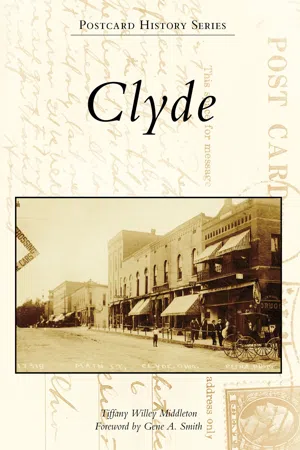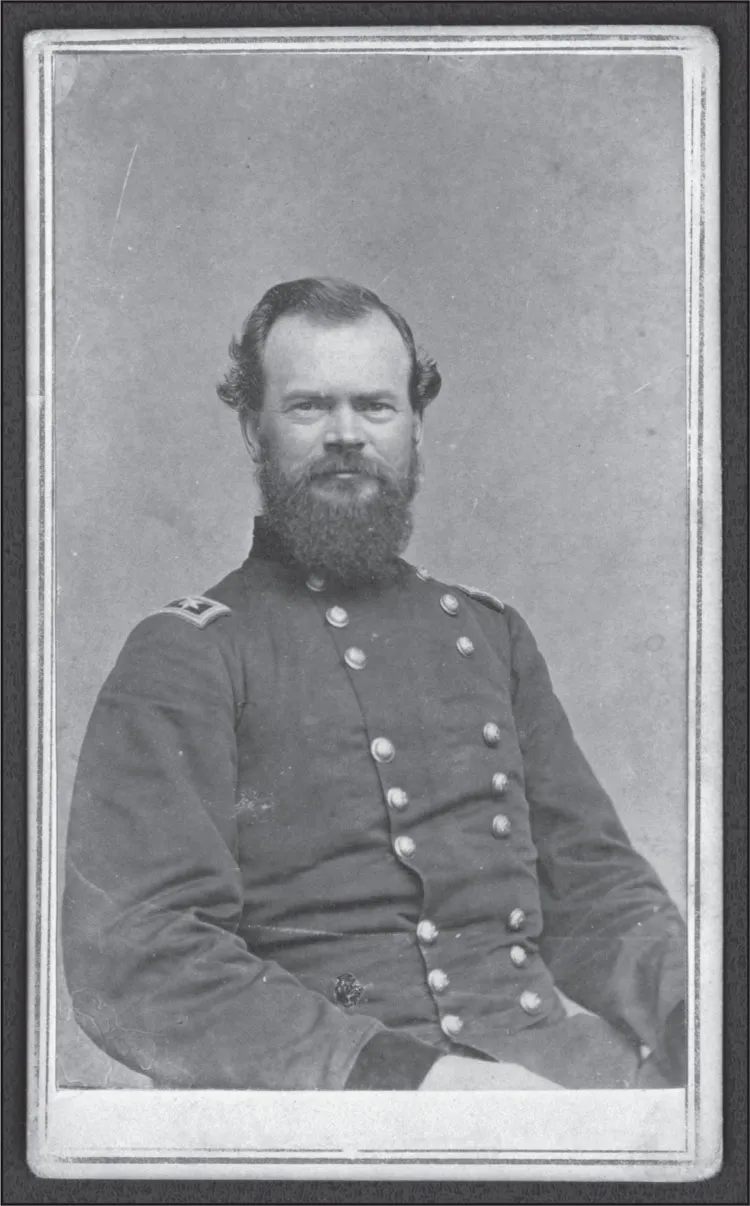
eBook - ePub
Clyde
Tiffany Willey Middleton
This is a test
- 128 Seiten
- English
- ePUB (handyfreundlich)
- Über iOS und Android verfügbar
eBook - ePub
Clyde
Tiffany Willey Middleton
Angaben zum Buch
Buchvorschau
Inhaltsverzeichnis
Quellenangaben
Über dieses Buch
Clyde is a community located in northwest Ohio, less than one hour southeast of Toledo, with a population of approximately 6, 500 people. In many ways, Clyde is a famous small town--it has been launched into the national spotlight numerous times during its 150-year history. Clyde was the home of Civil War hero James B. McPherson, political cartoonist James Albert Wales, author Sherwood Anderson, and World War II hero Rodger Young. The images in this volume provide windows into Clyde's storied history and offer glimpses of the everyday moments shared by its citizens.
Häufig gestellte Fragen
Wie kann ich mein Abo kündigen?
Gehe einfach zum Kontobereich in den Einstellungen und klicke auf „Abo kündigen“ – ganz einfach. Nachdem du gekündigt hast, bleibt deine Mitgliedschaft für den verbleibenden Abozeitraum, den du bereits bezahlt hast, aktiv. Mehr Informationen hier.
(Wie) Kann ich Bücher herunterladen?
Derzeit stehen all unsere auf Mobilgeräte reagierenden ePub-Bücher zum Download über die App zur Verfügung. Die meisten unserer PDFs stehen ebenfalls zum Download bereit; wir arbeiten daran, auch die übrigen PDFs zum Download anzubieten, bei denen dies aktuell noch nicht möglich ist. Weitere Informationen hier.
Welcher Unterschied besteht bei den Preisen zwischen den Aboplänen?
Mit beiden Aboplänen erhältst du vollen Zugang zur Bibliothek und allen Funktionen von Perlego. Die einzigen Unterschiede bestehen im Preis und dem Abozeitraum: Mit dem Jahresabo sparst du auf 12 Monate gerechnet im Vergleich zum Monatsabo rund 30 %.
Was ist Perlego?
Wir sind ein Online-Abodienst für Lehrbücher, bei dem du für weniger als den Preis eines einzelnen Buches pro Monat Zugang zu einer ganzen Online-Bibliothek erhältst. Mit über 1 Million Büchern zu über 1.000 verschiedenen Themen haben wir bestimmt alles, was du brauchst! Weitere Informationen hier.
Unterstützt Perlego Text-zu-Sprache?
Achte auf das Symbol zum Vorlesen in deinem nächsten Buch, um zu sehen, ob du es dir auch anhören kannst. Bei diesem Tool wird dir Text laut vorgelesen, wobei der Text beim Vorlesen auch grafisch hervorgehoben wird. Du kannst das Vorlesen jederzeit anhalten, beschleunigen und verlangsamen. Weitere Informationen hier.
Ist Clyde als Online-PDF/ePub verfügbar?
Ja, du hast Zugang zu Clyde von Tiffany Willey Middleton im PDF- und/oder ePub-Format sowie zu anderen beliebten Büchern aus Geschichte & Nordamerikanische Geschichte. Aus unserem Katalog stehen dir über 1 Million Bücher zur Verfügung.
Information
Thema
GeschichteOne
A “FAMOUS
SMALL TOWN”
SMALL TOWN”

McPherson Cemetery, located at the corner of McPherson Highway and East Maple Street, is Clyde’s most storied cemetery. It was named after Clyde native Gen. James B. McPherson (1828–1864), the second-highest-ranking Union officer killed during the Civil War, who is buried there alongside his mother and father. His grave is marked with a bronze statue. The cemetery land was once part of a 150-acre farm owned by Albert Guinall (1823–1852). As the story goes, Albert’s wife, Nellie, became ill and pointed to the hill where the statue now stands and requested, “Let me be carried there.” Albert fenced off a plot around the hill, which became a small cemetery. Nellie recovered, but the Guinalls were eventually buried there, and the area became known as Evergreen Cemetery. It became a public cemetery for the growing city of Clyde in 1868. In this postcard view, the cemetery looks tranquil after a fresh snow on February 14, 1909. The statue of General McPherson is visible through the trees. (Randy Dick.)

James Birdseye McPherson was born in Clyde in 1828 to William R. and Cynthia Russell McPherson. The McPherson home still stands in Clyde at the corner of Maple Street and McPherson Highway. McPherson attended the nearby Norwalk Academy and graduated from the US Military Academy at West Point in 1853. He spent his career in the military, initially with the Corps of Engineers overseeing projects along the Hudson River in New York and at Alcatraz Island in San Francisco. During the Civil War, McPherson was promoted to general and given command of Union army commander Ulysses S. Grant’s Army of Tennessee. McPherson was killed during the Battle of Atlanta on July 22, 1864. He was the second-highest-ranking Union officer to die during the war. He was buried in what was then known as Evergreen Cemetery; it was rededicated as McPherson Cemetery in his honor in 1881. This photograph of McPherson was taken by famed Civil War photographer Mathew Brady sometime between 1862 and 1864. (Library of Congress.)

A bronze statue in McPherson Cemetery marks the grave of James B. McPherson. It was designed by Louis Rebisso (1839–1899), of Cincinnati, Ohio, and was paid for by the people of Clyde and surrounding Sandusky County and other Civil War veterans. They worked for over a decade to raise the necessary funds. The statue depicts McPherson standing with his weaponry and binoculars and pointing north. His foot rests on a cannon, while cannonballs sit at the base of the statue. The memorial was dedicated on July 22, 1881. It was reported that over 10,000 people attended the event. Pres. Rutherford B. Hayes eulogized the general during the dedication: “His name will be forever found on the shining roll of the world’s best-loved heroes.” Other ceremony attendees included Cynthia McPherson, the general’s mother, and Gen. William Tecumseh Sherman, who served with McPherson during the Civil War. (Randy Dick.)

The iron gates that frame the entrance to McPherson Cemetery were installed in 1901. The entrance to the cemetery was moved to its current position from Maple Street at the end of the 19th century. After the dedication of the McPherson statue in 1881, the cemetery continued to grow. In 1897, Clyde city officials hired Cleveland landscape architect Arthur Babcox to beautify the cemetery and make it more like a park. This undated postcard shows the cemetery on a sunny day during the 20th century. Note the expansive green space and tall trees in the cemetery, as well as the detailed columns and fencing that surround it. In the foreground of the postcard, outside of the cemetery gates, brick pavers span McPherson Highway. (Randy Dick.)

Political cartoonist James Albert Wales (1852–1886) was buried in McPherson Cemetery. He was born in Clyde and became a nationally known caricaturist. He drew cartoons for popular magazines of the 19th century, including Puck and Harper’s Weekly, and was one of the founders of Judge. Wales was the first native-born American political cartoonist to achieve national notoriety. When he died in 1886, the New York Times ran his obituary. An example of his work includes this cover illustration for the July 13, 1881, issue of Puck. The cartoon depicts Charles Guiteau, who was convicted of assassinating Pres. James Garfield. Guiteau felt largely responsible for Garfield’s election and was disgruntled after not receiving a presidential appointment among the Garfield administration. The cartoon shows him holding a note, “An office or your life!” while standing outside of the White House ready to ring the “president’s bell.” (Library of Congress.)

This granite statue of George Burton Meek (1872–1898) stands inside McPherson Cemetery to mark the grave of Meek, who is believed to have been the first American serviceman killed during the Spanish-American War. He was born in nearby Riley Township and enlisted in the US Navy in 1892. Fireman First Class Meek was killed aboard the torpedo boat USS Winslow at Cardenas, Cuba, on May 11, 1898. He was buried in McPherson Cemetery in 1899 after a parade in his honor through downtown Clyde. The State of Ohio erected the memorial, which was dedicated by Ohio governor Frank Willis on May 11, 1916. The statue stands 13 feet tall and was designed and produced locally by the Hughes Granite Company. (Randy Dick.)

There are over 13,000 people interred at McPherson Cemetery, including city leaders, longtime residents, and other influential persons. Notable burials include Benjamin Collins (d. 1825), the first constable of Green Creek Township; Charles Henry McCleary (d. 1906), who was awarded the Congressional Medal of Honor for his service during the Civil War; local merchant Alonzo Wilder (d. 1912); Sarah Suggitt (d. 1932), a local high school teacher who gifted $3,500 to friends who established a fund at the Clyde Public Library in her honor to buy books for the community; former mayor and local businessman Winfield Adare (d. 1932); Silas Richards (d. 1946), a local judge who was instrumental in securing funding to build the Clyde Public Library; local artist Franklyn Hall (d. 1965); and local architect and historian Thaddeus Hurd (d. 1989). (Above, Clyde Museum; below, Randy Dick.)


One of McPherson Cemetery’s most renowned “residents” is Rodger Young, who died in 1943 during World War II after putting himself in harm’s way to allow other members of his platoon to withdraw from enemy fire. His actions were immortalized in the song “The Ballad of Rodger Young,” by Frank Loesser. He was posthumously awarded the Medal of Honor, the United States’ highest military honor. Young was born in Tiffin, Ohio, in 1918, and lived in nearby Green Springs before moving to Clyde. He enlisted in the Ohio National Guard in 1938. In 1942, Young’s unit was deployed to Fiji, then the Solomon Islands, then New Georgia. There, on July 31, 1943, Young’s platoon was ambushed by Japanese soldiers as they were returning to camp. With everyone under enemy fire and some injuries, the platoon was ordered to withdraw. Young continued to proceed, which allowed him opportunities to inflict casualties and allowed his fellow soldiers time to escape. He was initially buried on New Georgia, but in 1949, his body was returned to the United States and buried in Clyde. (Ohio History Connection.)

Eli Perkins was the pen name and stage name of humorist lecturer Melville DeLancey Landon (1839–1910). He was from New York, served in the Union army during the Civil War, and appeared at Terry’s Hall in Clyde on January 13, 1880. The city directory from 1887 lists Terry’s Hall, or Terry’s Opera House, as located at 106–110 South Main Street, which is where the Clyde–Green Springs School Board office is now located. (Randy Dick.)

Emma D. Lemon was a professional orator who traveled around the country performing dramatic readings, primarily from 1893 until 1897. This postcard advertises her “grand elocutionary and dramatic entertainment” for an appearance in Clyde on November 15, 1883. She was a graduate of the Boston School of Oratory (now known as Emerson College) in Boston. The Elyria Republican, the local newspaper from nearby Elyria, Ohio...